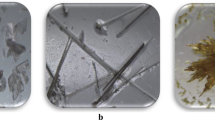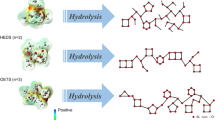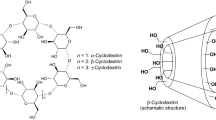Abstract
In this study for the first time the temperature dependences of the heat capacity C 0p and enthalpies of physical transitions of carbosilane dendrimers with diundecylsilyl and diundecylsiloxane terminal groups of the fifth generation have been measured using the methods of precision adiabatic vacuum calorimetry and differential scanning calorimetry over the range from 6 to 580 K. In the above temperature ranges the physical transformations have been detected and their thermodynamic characteristics were estimated and analyzed. The standard thermodynamic functions: heat capacity C 0p (T), enthalpy H°(T) − H°(0), entropy S°(T) − S°(0), and free Gibbs energy G°(T) − H°(0) and standard entropies of formation of dendrimers at T = 298.15 K have been calculated over the range from T → 0 K to 580 K. The thermodynamic properties of studied dendrimers have been compared.



Similar content being viewed by others
References
Tomalia DA, Naylor AM, Goddart WA. Starburst dendrimers: molecular-level control of size, shape, surface chemistry, topology, and flexibility from atoms to macroscopic matter. Angew Chem Int Ed Engl. 1990;29:138–75.
Newkome GR. Advances in dendritic macromolecules. Greenwich: JAI Press; 1994.
Astruc D, Chardac F. Dendritic catalysts and dendrimers in catalysis. Chem Rev. 2001;101:2991–3023.
Muzafarov AM, Rebrov EA, Papkov VS. Three-dimensionally growing polyorganosiloxanes. Possibilities of molecular construction in highly functional systems. Russ Chem Rev. 1991;60:807–14.
Beletskaya IP, Chuchuryukin AV. Synthesis and properties of functionalized dendrimers. Russ Chem Rev. 2000;69:639–60.
Lorenz K, Mulhaupt R, Frey H, Rapp U. Mayer-Posner F.J. Carbosilane-based dendritic polyols. Macromolecules. 1995;28:6657–61.
Wooley KL, Hawker CJ, Pochan JM, Frechet GMJ. Physical properties of dendritic macromolecules: a study of glass transition temperature. Macromolecules. 1993;26:1514–9.
Lorenz K, Frey H, Stuhn B, Mulhaupt R. Carbosilane dendrimers with perfluoroalkyl end groups. Core–shell macromolecules with generation-dependent. order macromolecules. 1997;30:6860–8.
Lebedev BV, Smirnova NN, Ryabkov MV, Ponomarenko SA, Makeev EA, Boiko NI, Shibaev VP. Thermodynamic properties of carbosilane dendrimer of the first generation with terminal methoxyundecylenate groups in the range 0–340 K. Polym Sci Ser A. 2001;43:323–31.
Ryabkov MV, Kulagina TG, Lebedev BV. Thermodynamic properties of carbosilane dendrimers of the first and second generations with terminal allyl groups in the range 0–340 K. Russ J Phys Chem. 2001;75:1988–96.
Lebedev BV, Ryabkov MV, Tatarinova EA, Rebrov EA, Muzafarov AM. Thermodynamic properties of the first to fifth generations of carbosilane dendrimers with allyl terminal groups. Russ Chem Bull. 2003;52:545–51.
Smirnova NN, Lebedev BV, Khramova NM, Tsvetkova LYa, Tatarinova EA, Myakushev VD, Muzafarov AM. The thermodynamic properties of carbosilane dendrimers of the sixth and seventh generations with terminal groups in the temperature range 6–340 K. Russ J Phys Chem. 2004;78:1369–74.
Smirnova NN, Stepanova OV, Bykova TA, Muzafarov AM, Tatarinova EA, Myakushev VD. Thermodynamic properties of carbosilane dendrimers of the third to the sixth generations with terminal butyl groups in the range from T → 0 to 600 K. Thermochim Acta. 2006;440:188–94.
Smirnova NN, Stepanova OV, Bykova TA, Markin AV, Tatarinova EA, Muzafarov AM. Thermodynamic properties of carbosilane dendrimers of the seventh and ninth generations with terminal butyl groups in the temperature range from T → 0 to 600 K. Russ Chem Bull. 2007;56:1991–5.
Lebedev BV, Kulagina TG, Ryabkov MV, Ponomarenko SA, Makeev EA, Boiko NI, Shibaev VP, Rebrov EA, Musafarov AM. Carbosilane dendrimer of second generation with terminal methoxyundecylenate groups. J Therm Anal Calorim. 2003;71:481–92.
Tereshchenko AS, Tupitsyna GS, Tatarinova EA, Bystrova AV, Muzafarov AM, Smirnova NN, Markin AV. Carbosilane dendrimers with diundecylsilyl, diundecylsiloxane, and tetrasiloxane terminal groups: synthesis and properties. Polym Sci Ser B. 2010;52:41–8.
Varushchenko RM, Druzhinina AI, Sorkin EL. Low-temperature heat capacity of 1-bromoperfluorooctane. J Chem Thermodyn. 1997;29:623–7.
Malyshev VM, Milner GA, Sorkin EL, Shibakin VF. Automatic low-temperature calorimeter. Pribory i Tekhnika Eksperimenta. 1985;6:195–7.
Paukov IE, Kovalevskaya YA, Kiseleva IA, Shuriga TN. A low-temperature heat capacity study of natural lithium micas. J Therm Anal Calorim. 2010;992:709–12.
Yagfarov MSh. Novii metod izmerenia teploemkostei i teplovih effektov. Zh Fiz Khimii. 1969;43:1620–5.
Kabo AG, Diky VV. Details of calibration of a scanning calorimeter of the triple heat bridge type. Thermochim Acta. 2000;347:79–84.
Lazarev VB, Izotov AD, Gavrichev KS, Shebershneva OV. Fractal model of heat capacity for substances with diamond-like structures. Thermochim Acta. 1995;269–270:109–16.
Tarasov VV. Theory of heat capacity of chain and layer structures. Zhurnal fizicheskoi khimii. 1950;24:111–28.
Alford S, Dole M. Specific heat of synthetic high polymers. VI. Study of the glass transition in polyvinyl chloride. J Chem Soc. 1955;77:4774–7.
Smirnova NN, Lebedev BV, Bykova TA, Markin AV, Tur DR. Thermodynamic properties of poly-[bis(trifluoroetoxy)-phosphazene] in the range from T → 0 to 620 K. J Therm Anal Calorim. 2009;95:229–34.
Wunderlich B. Thermodynamic description of condensed phases. J Therm Anal Calorim. 2010;102:413–24.
Kauzmann W. The Nature of the glassy state and the behavior of liquids at low temperatures. Chem Rev. 1948;43:219–56.
Adam G, Gibbs JU. On the temperature dependence of cooperative relaxation properties in glass-forming liquids. J Chem Phys. 1965;43:139–46.
Bestul A, Chang SS. Excess entropy at glass transformation. J Chem Phys. 1964;40:3731–3.
Rabinovich IB, Nistratov VP, Telnoy VI, Sheiman MS. Thermochemical and thermodynamic properties of organometallic compounds. New York: Begell House Inc. Publishers; 1999.
Lebedev BV. Thermodynamics of polymers. Gorky: Gorky State University; 1989.
Cox JD, Wagman DD, Medvedev VA. Codata key values for thermodynamics. New York; 1984. Database http://webbook.nist.gov/chemistry/.
Chase MW Jr. NIST-JANAF themochemical tables. 4th ed. J Phys Chem Ref Data Monogr. 1998;9:1951. Database http://webbook.nist.gov/chemistry/.
Acknowledgements
This study was financially supported by the Russian Foundation for Basic Research (project 08-03-00214a).
Author information
Authors and Affiliations
Corresponding author
Rights and permissions
About this article
Cite this article
Markin, A.V., Samosudova, Y.S., Smirnova, N.N. et al. Thermodynamics of carbosilane dendrimers with diundecylsilyl and diundecylsiloxane terminal groups. J Therm Anal Calorim 105, 663–676 (2011). https://doi.org/10.1007/s10973-010-1199-5
Published:
Issue Date:
DOI: https://doi.org/10.1007/s10973-010-1199-5




